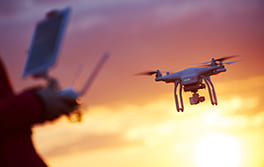
The use of drones, also known as unmanned aerial vehicles (UAVs), has exploded in recent years across a variety of industries. From package delivery to agriculture, drones have proven to be a valuable asset due to their ability to cover large areas quickly and efficiently.
To track and optimize the performance of these drones, a new market has emerged: drone telematics.
Drone telematics refers to the use of technology to track, monitor, and optimize the performance of drones in real time. This includes a wide range of services such as flight planning, real-time location tracking, and remote diagnostics. Drone telematics can also provide important safety features such as collision avoidance and emergency landing support.
One key aspect of the drone telematics market is the range of the technology. Drones can be classified into three main categories based on their range: long-range, medium-range, and short-range.
Long-range drones, as the name suggests, can fly over long distances. These drones are often used for long-distance delivery services, search and rescue operations, and surveillance. Some examples of long-range drones include the DJI Matrice 600 and the AeroVironment Global Observer.
Medium-range drones, on the other hand, have a shorter range than long-range drones but can still cover a significant distance. These drones are often used for tasks such as mapping, inspection, and data collection. Some examples of medium-range drones include the DJI Phantom 4 RTK and the Parrot Anafi USA.
Short-range drones have a limited range and are typically used for tasks that require a high level of precision and stability. These drones are often used for inspection, photography, and videography. Some examples of short-range drones include the DJI Mavic Air 2 and the Skydio 2.
The drone telematics market is expected to experience significant growth in the coming years.
Drone Telematics Market Size was valued at a CAGR of 7% over the forecast period 2022-2028. Telematics is the most extensively used car technology. However, the demand for drone telematics is projected to skyrocket shortly. This is because drones are increasingly being used for commercial and defence purposes. Drone telematics enables the efficient management of a large number of drones while increasing operational efficiency.
It enables commercial and defence end customers with expertise to remotely monitor drone location and information. Furthermore, in logistics and transportation, drone telematics enables organizations to track numerous supply chain activities.
One of the key drivers of the drone telematics market is the increasing use of drones in the logistics and transportation industry. Drones are being used for tasks such as package delivery, cargo transportation, and the inspection of infrastructure. The use of drones in these applications can help improve efficiency, reduce costs, and increase safety.
The agriculture industry is also seeing increasing adoption of drones for tasks such as crop monitoring, pest control, and irrigation. Drones can provide real-time data on the health of crops and allow farmers to make more informed decisions about how to best care for their crops.
In addition to these industries, drones are also being used in a variety of other applications such as search and rescue, public safety, and entertainment. The use of drones in these applications is expected to further drive growth in the drone telematics market.
As the drone telematics market continues to grow, it is important for companies to carefully consider their range needs when selecting a drone. Long-range drones may be necessary for tasks such as long-distance delivery, while medium and short-range drones may be more suitable for tasks that require a high level of precision and stability.
In conclusion, the drone telematics market is poised for significant growth in the coming years. With an increasing demand for drones across various industries and advancements in drone technology.
Hi! Click one of our member below to chat on Phone